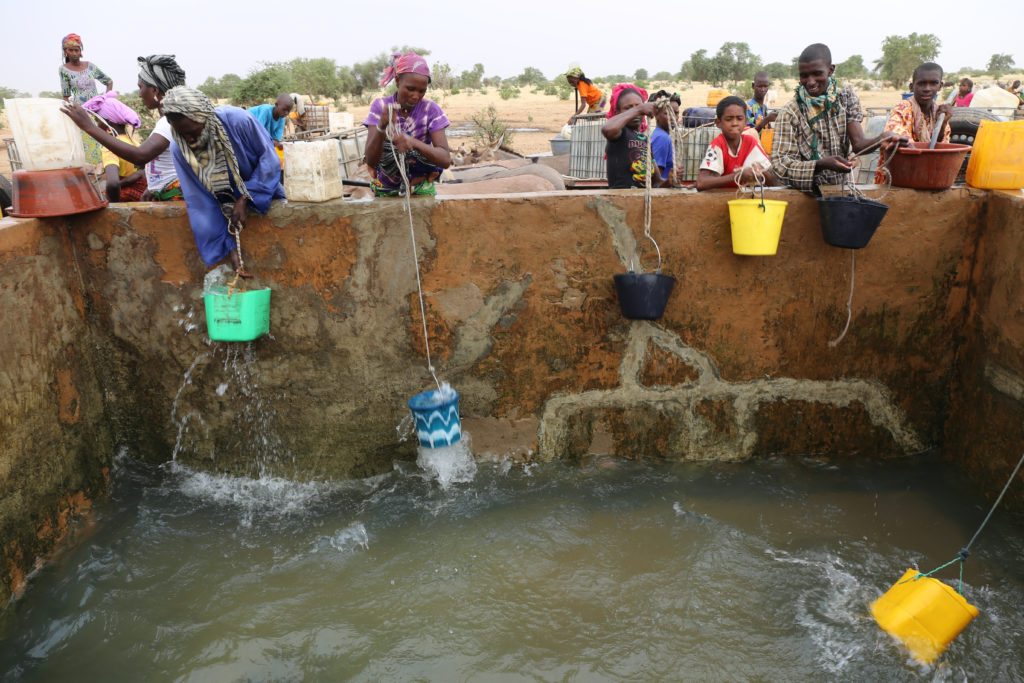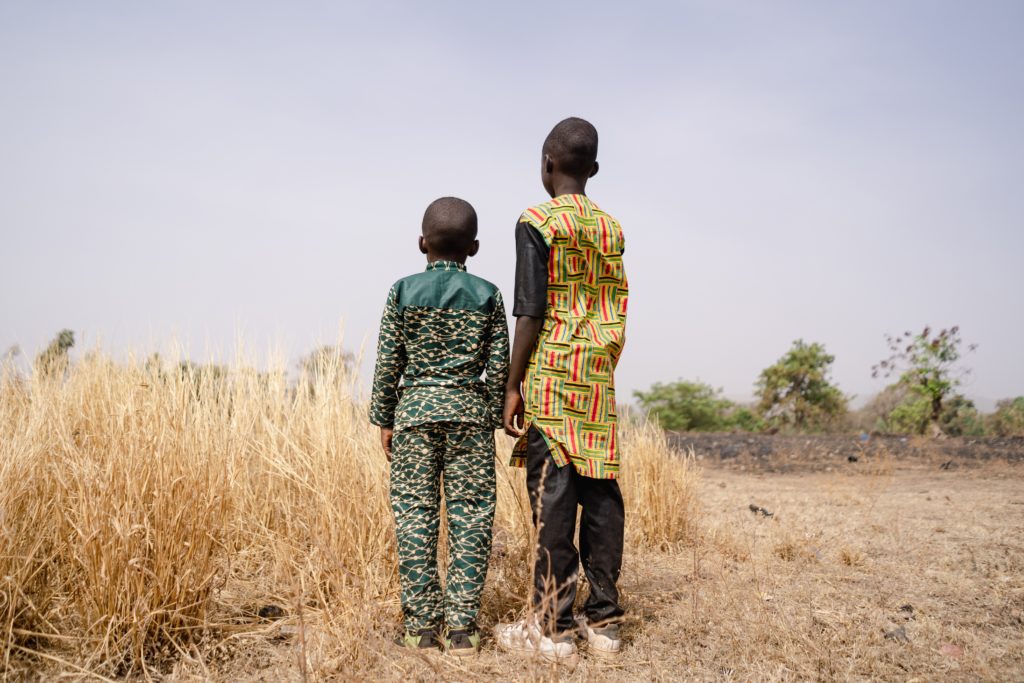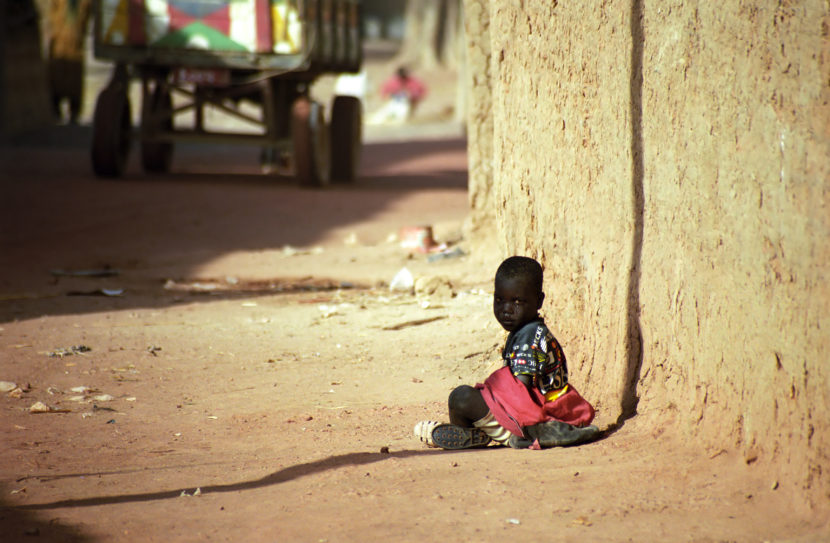The evocation of conflicts, terrorism, and violation of children’s rights is, unfortunately, nothing new, given the events that have affected the Sahel region in recent years. As a result of the inherent violence in conflicts, major migratory flows, and desperate humanitarian needs, children are deprived of their fundamental rights and protection against the dangers threatening them. The Sahelian children must obtain what they are missing: access to services of first needs and the ability to enjoy all their rights the same way as all other children in the world do.
The security context and conflicts in the Sahel
The Sahel represents “the transition area that separates the Sahara Desert to the north and the Sudanian zone to the south.” It is an African region that generally includes ten countries: Burkina Faso, Cameroon, The Gambia, Guinea, Mali, Mauritania, Niger, Nigeria, Senegal and Chad (Oxfam France, 2022).
While the Sahel region is rich in human potential and carrier of development, it is unfortunately facing a multidimensional crisis. Indeed, numerous of the region’s crises and conflicts are fueled by deep inequalities that divide certain sections of the population: political crises, forced displacements, humanitarian, economic, environmental, climatic, food, and security crises (Oxfam France, 2022).
The non-state armed groups engage in large-scale attacks against civilian and military targets and clash in search for control and influence over territories and access to resources. More specifically, terrorism and violent extremist groups target “frequently border areas, particularly the tri-border area of Burkina Faso, Mali, and Niger, known as the Liptako-Gourma” (UN Info, 2023).
Children, the first to be affected by increased migration
The Central Sahel region, which includes in particular Burkina Faso, Mali, Mauritania, and Niger, is facing a severe humanitarian and protection crisis that has already pushed millions of people, among them many children, to leave their homes (UNHCR, 2023). To illustrate the above with key figures, the following countries are concerned:
- Ivory Coast: 37,685 arrivals, including 10,867 school-age children.
- Ghana: 15,000 arrivals, mainly from Burkina Faso, including 1,416 children.
- Togo: 18,429 displaced people, including 9,030 children.
- Benin: 23,533 displaced persons, including 14,120 children (UNICEF, 2024).
Overall, as identified by UNICEF, among the 1.6 million refugees, displaced persons, and host communities affected, 994,000 are children (UNICEF, 2024).
The humanitarian needs of Sahelian children

Due to the frequency of cross-border and internal population movements, particularly resulting from conflicts in the Sahel, the already fragile social services such as health, nutrition, and education are under severe strain. Access to vital resources such as food, drinking water, and housing, which are already restricted, is becoming extremely problematic (UNICEF, 2024). Around 46.7 million children face humanitarian live-saving needs in West Africa (UNICEF, 2023).
Nutrition needs
Malnutrition and stunting rates among children under five in the Sahel region belong to the highest in the world (United Nations Development Programme, 2024). The consequences of malnutrition and famine threaten more than four million children under the age of five, which represents 35% of the entire under-five population (Save the Children, 2022).
In Mali, Niger, and Burkina Faso, climate change, conflicts, and rising poverty resulting from the pandemic will lead to a difficult period between harvest and planting, jeopardising essential food supplies and forcing vulnerable families to restrict their daily meals further (Save the Children, 2022).
The need for access to education
An upsurge of violence in the Sahel, particularly in Burkina Faso, Niger, and Mali, has led to the closure of almost 7,800 primary schools, representing a 20% increase in the number of closures over the past year. As a result, in June 2023, around 1.4 million children were no longer benefiting from education and the skills they will need to participate in the life of their communities as adults (Save the Children, 2023).
Under these conditions, children and adolescents are out of school and face the risk of exploitation, child marriage, migration, particularly unaccompanied and from their family separated children, and gender-based violence, which disproportionately affects girls (UNICEF, 2024). Additionally, in these three countries, schools have been closed to halt the spread of the pandemic, thus disrupting the education of around 13 million children temporarily out of school (Save the Children, 2020).
Health needs
Health indicators in the Sahel are among the worst in the world. The region has one of the highest maternal mortality rates worldwide, reaching 856 deaths per 100,000 live births due to inadequate access to maternal and reproductive healthcare and a high prevalence of early marriage. Armed attacks on civilians and public infrastructure, in particular on health facilities and schools, combined with drought, soil degradation, and the unpredictability of the climate, exacerbate the plight of millions of people in the Sahel (World Health Organization, 2022).
The children in the Sahel region are desperate for water, sanitation, and hygiene. Investing in basic needs services will allow sustainable solutions for these vulnerable communities, especially for children whose health and well-being depend on it (UNICEF, 2024).
Children need extra vigilance and protection
The context of conflicts in the Sahel, migration, malnutrition, being out of school, lack of water, hygiene, and healthcare – this is the infernal spiral that children in the Sahel region suffer daily.
Climate change also poses increasing threats to the Sahel, as rising temperatures, sea levels, and changing rainfall patterns harm livelihoods, food security, health, and economic growth and are likely to fuel conflict (United Nations Development Programme, 2024). In addition, a lack of funding remains a major obstacle to humanitarian response in the region (UNICEF, 2023).
To guarantee the well-being and ongoing protection of children, the following actions must be implemented by the international community on the ground and the main public players in Sahelian countries:
- Administer essential care and vaccinations to children, particularly against measles and malaria (Malaria Consortium, 2015).
- Treat severe wasting in children aged between 6 and 59 months.
- Guarantee access to a sufficient quantity and quality of water for drinking and domestic needs (UNICEF, 2023).
- Provide an emergency education programme integrating child protection, mental health, and psychosocial support (Save the Children, 2022).
- Parties to the conflict must fulfil their fundamental moral and legal obligations to children under international humanitarian law and human rights law, specifically protecting schools from military use, refraining from the use of food deprivation as a weapon of war, and not impeding access to health services and clean water (Save the Children, 2020).
Due to the seriousness of the situation in certain Sahel countries, it is essential to provide emergency humanitarian aid to the following countries:
- Burkina Faso, due to the multidimensional humanitarian crisis that has further aggravated since 2019.
- Cameroon, where 2.5 million children are in urgent need of humanitarian assistance due to complex and multi-faceted crises such as armed conflict and violence.
- Mali, where more than 40% of the population has increasing humanitarian needs, without precedent.
- Niger, where children continue to face persistent armed conflicts, climatic disasters, nutritional emergencies, and epidemics.
- Nigeria, where armed conflict continues to affect the lives and prospects of 60% of children (UNICEF, 2023).

Through its projects, Humanium strives to create a world where children’s rights to education and health are always respected. If you wish to contribute to Humanium’s cause, you may consider donating, volunteering, or becoming a member.
Written by Moïra Phuöng Van de Poël
Translated by Or Salama
Proofread by Alexandra Dantl
Bibliography:
Malaria Consortium (2015, septembre 16). Urgent political support needed to protect the Sahel’s 25 million children. Extrait de Malaria Consortium à https://www.malariaconsortium.org/news-centre/video-urgent-political-support-needed-to-protect-the-sahels-25-million-children-politics-home.htm, consulté en mars 2024.
ONU Info (2023, mai 16). La situation sécuritaire au Sahel reste très préoccupante, prévient l’ONU. Extrait d’ONU Info à https://news.un.org/fr/story/2023/05/1135207, consulté en mars 2024.
Oxfam France (2022, mai 10). A la découverte du Sahel, la porte entre deux Afriques. Extrait d’Oxfam France à https://www.oxfamfrance.org/financement-du-developpement/qu-est-ce-que-le-sahel/, consulté en mars 2024.
Save the Children (2022, mai 12). More than 1 in 3 children under five at risk of starvation in Central Sahel. Extrait de Save the Children à https://www.savethechildren.net/news/more-1-3-children-under-five-risk-starvation-central-sahel, consulté en mars 2024.
Save the Children (2022, octobre 10). Sahel : mental health is vital to children in conflict. Extrait de Save the Children à https://mali.savethechildren.net/news/sahel-mental-health-vital-children-conflict, consulté en mars 2024.
Save the Children (2023, septembre 8). Sahel schools closures increase by 20% in past year, with 200.000 more children out of class. Extrait de Save the Children à https://www.savethechildren.net/news/sahel-school-closures-increase-20-past-year-200000-more-children-out-class, consulté en mars 2024.
Save the Children (2020, october). The Central Sahel – A children’s crisis. Extrait de Save the Children à https://resourcecentre.savethechildren.net/pdf/sahel_brief_3.pdf/, consulté en mars 2024.
The World Bank (2024, janvier 4). Enhancing Food and Nutrition Security in the Sahel and Horn of Africa. Extrait de The World Bank à https://www.worldbank.org/en/results/2024/01/04/enhancing-food-and-nutrition-security-in-the-sahel-and-horn-of-afe-africa, consulté en mars 2024.
UNHCR (2023). Sahel situation. Extrait d’ UNHCR à https://reporting.unhcr.org/operational/situations/sahel-situation, consulté en mars 2024.
UNICEF (2023, mars 17). 10 million children in extreme jeopardy in central Sahel as insecurity seeps into neighbouring countries. Extrait d’UNICEF à https://www.unicef.org/press-releases/10-million-children-extreme-jeopardy-central-sahel-insecurity-seeps-neighbouring, consulté en mars 2024.
UNICEF (2023, décembre 22). 46.7 million children at risk of malnutrition, displacement, poor health & learning loss in West and Central Africa due to conflict and displacement. Extrait d’UNICEF à https://reliefweb.int/report/burkina-faso/467-million-children-risk-malnutrition-displacement-poor-health-learning-loss-west-and-central-africa-due-conflict-and-displacement, consulté en mars 2024.
UNICEF (2024). Response in coastal countries linked to central Sahel crisis spillover. Extrait d’UNICEF à https://www.unicef.org/media/149891/file/2024-HAC-Sahel-Crisis-Spillover.pdf, consulté en mars 2024.
United Nations Development Programme (2024, janvier). Sahel Human Development Report 2023. Extrait d’ United Nations Development Programme à https://www.undp.org/sites/g/files/zskgke326/files/2024-02/undp-hdr-sahel-report-eng_web_0_1.pdf, consulté en mars 2024.
World Health Organization (2022, avril 29). WHO releases more than US$ 8 million for the Sahel’s humanitarian response. Extrait de World Health Organization à https://www.afro.who.int/news/who-releases-more-us-8-million-sahels-humanitarian-response, consulté en mars 2024.


